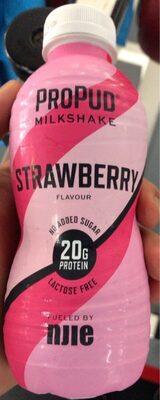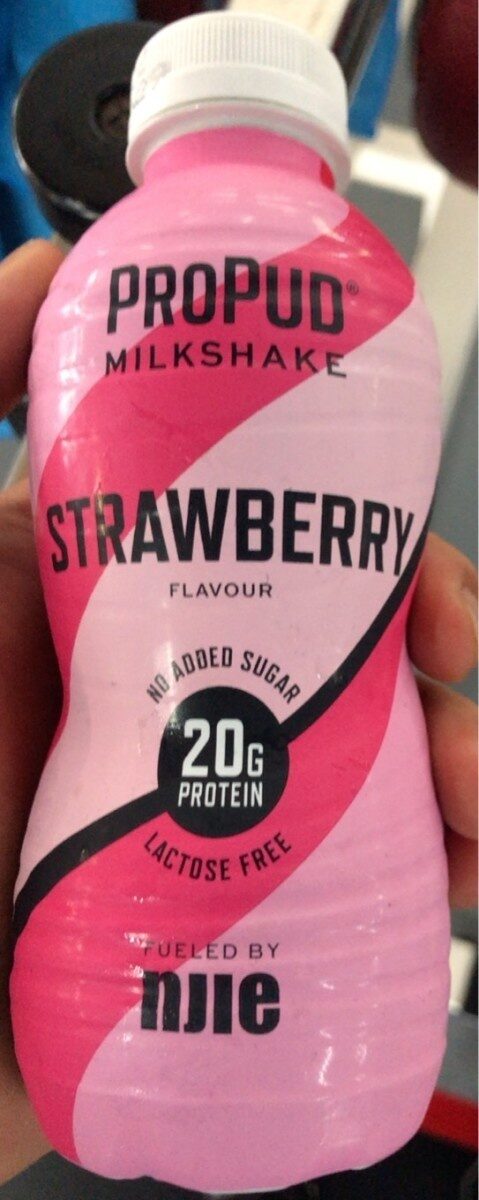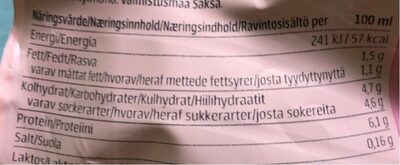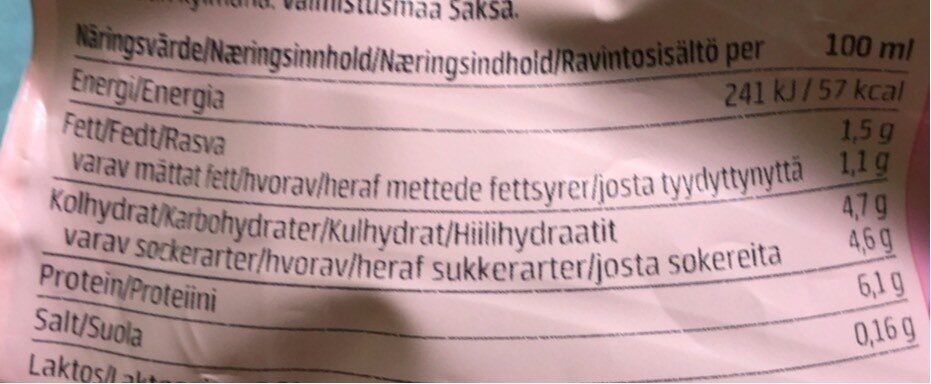Help us make food transparency the norm!
As a non-profit organization, we depend on your donations to continue informing consumers around the world about what they eat.
The food revolution starts with you!
Strawberry milkshake - Propud - 330 ml
Strawberry milkshake - Propud - 330 ml
This product page is not complete. You can help to complete it by editing it and adding more data from the photos we have, or by taking more photos using the app for Android or iPhone/iPad. Thank you!
×
Streckkod: 7350068295232 (EAN / EAN-13)
Vanligt namn: Laktosfri proteindryck med smakav jordgubb. Utan tillsatt socker.
Kvantitet: 330 ml
Förpackning: Plast, en:pet-polyethylene-terephthalate, HDPE
Kategorier: Drycker, Mejeriprodukt, en:Dairy drinks, Mjölk, en:Flavoured milks, en:Homogenized milks, Kosttillskott, H-mjölk, en:Bodybuilding supplements, en:Milkshakes, en:Protein shakes
Etiketter, certifieringar, utmärkelser:
en:Green Dot, Inget tillsat socker, Laktosfri
Tillverknings eller bearbetningsplats: Germany, Tyskland
Spårbarhetskod: DE BW-033 EG
Butiker: Coop
Länder där såld: Sverige
Matching with your preferences
Hälsa
Ingredienser
-
12 ingredienser
MJÖLK, MJÖLKPROTEIN, stabiliseringsmedel (karragenan, gellangummi), arom, sötningsmedel (acesulfam K, steviolglykosider), färgämne (karotener), laktasenzym.Allergener: Mjölk
Food processing
-
Ultra processed foods
Elements that indicate the product is in the 4 - Ultra bearbetade livsmedel och drycker group:
- Tillsats: E160a - Karoten
- Tillsats: E407 - Karragenan
- Tillsats: E418 - Gellangummi
- Tillsats: E950 - Acesulfam k
- Tillsats: E960 - Steviolglykosider
- Ingrediens: Färg
- Ingrediens: Arom
- Ingrediens: Mjölkprotein
- Ingrediens: Sötningsmedel
Food products are classified into 4 groups according to their degree of processing:
- Obearbetade eller minimalt bearbetade livsmedel
- Bearbetade kulinariska ingredienser
- Halvfabrikat
- Ultra processed foods
The determination of the group is based on the category of the product and on the ingredients it contains.
Tillsatser
-
E160a - Karoten
Carotene: The term carotene -also carotin, from the Latin carota, "carrot"- is used for many related unsaturated hydrocarbon substances having the formula C40Hx, which are synthesized by plants but in general cannot be made by animals -with the exception of some aphids and spider mites which acquired the synthesizing genes from fungi-. Carotenes are photosynthetic pigments important for photosynthesis. Carotenes contain no oxygen atoms. They absorb ultraviolet, violet, and blue light and scatter orange or red light, and -in low concentrations- yellow light. Carotenes are responsible for the orange colour of the carrot, for which this class of chemicals is named, and for the colours of many other fruits, vegetables and fungi -for example, sweet potatoes, chanterelle and orange cantaloupe melon-. Carotenes are also responsible for the orange -but not all of the yellow- colours in dry foliage. They also -in lower concentrations- impart the yellow coloration to milk-fat and butter. Omnivorous animal species which are relatively poor converters of coloured dietary carotenoids to colourless retinoids have yellowed-coloured body fat, as a result of the carotenoid retention from the vegetable portion of their diet. The typical yellow-coloured fat of humans and chickens is a result of fat storage of carotenes from their diets. Carotenes contribute to photosynthesis by transmitting the light energy they absorb to chlorophyll. They also protect plant tissues by helping to absorb the energy from singlet oxygen, an excited form of the oxygen molecule O2 which is formed during photosynthesis. β-Carotene is composed of two retinyl groups, and is broken down in the mucosa of the human small intestine by β-carotene 15‚15'-monooxygenase to retinal, a form of vitamin A. β-Carotene can be stored in the liver and body fat and converted to retinal as needed, thus making it a form of vitamin A for humans and some other mammals. The carotenes α-carotene and γ-carotene, due to their single retinyl group -β-ionone ring-, also have some vitamin A activity -though less than β-carotene-, as does the xanthophyll carotenoid β-cryptoxanthin. All other carotenoids, including lycopene, have no beta-ring and thus no vitamin A activity -although they may have antioxidant activity and thus biological activity in other ways-. Animal species differ greatly in their ability to convert retinyl -beta-ionone- containing carotenoids to retinals. Carnivores in general are poor converters of dietary ionone-containing carotenoids. Pure carnivores such as ferrets lack β-carotene 15‚15'-monooxygenase and cannot convert any carotenoids to retinals at all -resulting in carotenes not being a form of vitamin A for this species-; while cats can convert a trace of β-carotene to retinol, although the amount is totally insufficient for meeting their daily retinol needs.Källa: Wikipedia (Engelska)
-
E407 - Karragenan
Carrageenan: Carrageenans or carrageenins - karr-ə-gee-nənz, from Irish carraigín, "little rock"- are a family of linear sulfated polysaccharides that are extracted from red edible seaweeds. They are widely used in the food industry, for their gelling, thickening, and stabilizing properties. Their main application is in dairy and meat products, due to their strong binding to food proteins. There are three main varieties of carrageenan, which differ in their degree of sulfation. Kappa-carrageenan has one sulfate group per disaccharide, iota-carrageenan has two, and lambda-carrageenan has three. Gelatinous extracts of the Chondrus crispus -Irish moss- seaweed have been used as food additives since approximately the fifteenth century. Carrageenan is a vegetarian and vegan alternative to gelatin in some applications or may be used to replace gelatin in confectionery.Källa: Wikipedia (Engelska)
-
E418 - Gellangummi
Gellan gum: Gellan gum is a water-soluble anionic polysaccharide produced by the bacterium Sphingomonas elodea -formerly Pseudomonas elodea based on the taxonomic classification at the time of its discovery-. Its taxonomic classification has been subsequently changed to Sphingomonas elodea based on current classification system. The gellan-producing bacterium was discovered and isolated by the former Kelco Division of Merck & Company, Inc. in 1978 from the lily plant tissue from a natural pond in Pennsylvania, USA. It was initially identified as a substitute gelling agent at significantly lower use level to replace agar in solid culture media for the growth of various microorganisms Its initial commercial product with the trademark as "GELRITE" gellan gum, was subsequently identified as a suitable agar substitute as gelling agent in various clinical bacteriological media.Källa: Wikipedia (Engelska)
-
E950 - Acesulfam k
Acesulfame potassium: Acesulfame potassium - AY-see-SUL-faym-, also known as acesulfame K -K is the symbol for potassium- or Ace K, is a calorie-free sugar substitute -artificial sweetener- often marketed under the trade names Sunett and Sweet One. In the European Union, it is known under the E number -additive code- E950. It was discovered accidentally in 1967 by German chemist Karl Clauss at Hoechst AG -now Nutrinova-. In chemical structure, acesulfame potassium is the potassium salt of 6-methyl-1‚2,3-oxathiazine-4-3H--one 2‚2-dioxide. It is a white crystalline powder with molecular formula C4H4KNO4S and a molecular weight of 201.24 g/mol.Källa: Wikipedia (Engelska)
-
E960 - Steviolglykosider
Steviol glycoside: Steviol glycosides are the chemical compounds responsible for the sweet taste of the leaves of the South American plant Stevia rebaudiana -Asteraceae- and the main ingredients -or precursors- of many sweeteners marketed under the generic name stevia and several trade names. They also occur in the related species Stevia phlebophylla -but in no other species of Stevia- and in the plant Rubus chingii -Rosaceae-.Steviol glycosides from Stevia rebaudiana have been reported to be between 30 and 320 times sweeter than sucrose, although there is some disagreement in the technical literature about these numbers. They are heat-stable, pH-stable, and do not ferment. Additionally, they do not induce a glycemic response when ingested, because humans can not metabolize stevia. This makes them attractive as natural sugar substitutes for diabetics and other people on carbohydrate-controlled diets. Steviol glycosides stimulate the insulin secretion through potentiation of the β-cell, preventing high blood glucose after a meal. The acceptable daily intake -ADI- for steviol glycosides, expressed as steviol equivalents, has been established to be 4 mg/kg body weight/day, and is based on no observed effects of a 100 fold higher dose in a rat study.Källa: Wikipedia (Engelska)
Ingrediensanalys
-
Kan innehålla palmolja
Ingredienser som kan innehålla palmolja: E160a
-
Icke-vegan
Non-vegan ingredients: Mjölk, Mjölkprotein
-
Kanske Vegetariskt
Ingredients that may not be vegetarian: Arom, E160a, Laktas
-
Details of the analysis of the ingredients
: _MJÖLK_, _MJÖLKPROTEIN_, stabiliseringsmedel (karragenan, gellangummi), arom, sötningsmedel (acesulfam K, steviolglykosider), färgämne (karotener), laktasenzym- _MJÖLK_ -> en:milk - vegan: no - vegetarian: yes - ciqual_proxy_food_code: 19051 - percent_min: 14.2857142857143 - percent_max: 100
- _MJÖLKPROTEIN_ -> en:milk-proteins - vegan: no - vegetarian: yes - percent_min: 0 - percent_max: 50
- stabiliseringsmedel -> en:stabiliser - percent_min: 0 - percent_max: 33.3333333333333
- karragenan -> en:e407 - vegan: yes - vegetarian: yes - percent_min: 0 - percent_max: 33.3333333333333
- gellangummi -> en:e418 - vegan: yes - vegetarian: yes - percent_min: 0 - percent_max: 16.6666666666667
- arom -> en:flavouring - vegan: maybe - vegetarian: maybe - percent_min: 0 - percent_max: 5
- sötningsmedel -> en:sweetener - percent_min: 0 - percent_max: 5
- acesulfam K -> en:e950 - vegan: yes - vegetarian: yes - percent_min: 0 - percent_max: 5
- steviolglykosider -> en:e960 - vegan: yes - vegetarian: yes - percent_min: 0 - percent_max: 2.5
- färgämne -> en:colour - percent_min: 0 - percent_max: 5
- karotener -> en:e160a - vegan: maybe - vegetarian: maybe - from_palm_oil: maybe - percent_min: 0 - percent_max: 5
- laktasenzym -> en:lactase - vegan: maybe - vegetarian: maybe - percent_min: 0 - percent_max: 5
Näring
-
Very good nutritional quality
⚠ ️Varning: mängden fibrer är inte angiven, eventuella positiv inverkan på betyget kunde inte beaktas.⚠ ️Warning: the amount of fruits, vegetables and nuts is not specified on the label, it was estimated from the list of ingredients: 0This product is not considered a beverage for the calculation of the Nutri-Score.
Positiva poäng: 3
- Proteiner: 3 / 5 (värde: 6.1, avrundat värde: 6.1)
- Fiber: 0 / 5 (värde: 0, avrundat värde: 0)
- Frukt, grönsaker, nötter och raps- / valnöt- / olivoljor: 0 / 5 (värde: 0, avrundat värde: 0)
Negativa poäng: 2
- Energi: 0 / 10 (värde: 241, avrundat värde: 241)
- Socker: 1 / 10 (värde: 4.6, avrundat värde: 4.6)
- Mättat fett: 1 / 10 (värde: 1.1, avrundat värde: 1.1)
- Natrium: 0 / 10 (värde: 64, avrundat värde: 64)
The points for proteins are counted because the negative points are less than 11.
Näringsvärde: (2 - 3)
Nutri-Score:
-
Näringsvärden
-
Fett i låg kvantitet (1.1%)
What you need to know- A high consumption of fat, especially saturated fats, can raise cholesterol, which increases the risk of heart diseases.
Recommendation: Limit the consumption of fat and saturated fat- Choose products with lower fat and saturated fat content.
-
Mättat fett i måttlig kvantitet (1.1%)
What you need to know- A high consumption of fat, especially saturated fats, can raise cholesterol, which increases the risk of heart diseases.
Recommendation: Limit the consumption of fat and saturated fat- Choose products with lower fat and saturated fat content.
-
Sockerarter i måttlig kvantitet (4.6%)
What you need to know- A high consumption of sugar can cause weight gain and tooth decay. It also augments the risk of type 2 diabetes and cardio-vascular diseases.
Recommendation: Limit the consumption of sugar and sugary drinks- Sugary drinks (such as sodas, fruit beverages, and fruit juices and nectars) should be limited as much as possible (no more than 1 glass a day).
- Choose products with lower sugar content and reduce the consumption of products with added sugars.
-
Salt i måttlig kvantitet (0.16%)
What you need to know- A high consumption of salt (or sodium) can cause raised blood pressure, which can increase the risk of heart disease and stroke.
- Many people who have high blood pressure do not know it, as there are often no symptoms.
- Most people consume too much salt (on average 9 to 12 grams per day), around twice the recommended maximum level of intake.
Recommendation: Limit the consumption of salt and salted food- Reduce the quantity of salt used when cooking, and don't salt again at the table.
- Limit the consumption of salty snacks and choose products with lower salt content.
-
-
Näringsfakta
Näringsfakta Som såld
för 100 g / 100 mlSom såld
per portion (330 ml)Compared to: en:Protein shakes Energi 241 kj
(57 kcal)795 kj
(188 kcal)−10 % Fett 1,1 g 3,63 g +1 % Mättat fett 1,1 g 3,63 g +40 % Kolhydrat 4,7 g 15,5 g −27 % Sockerarter 4,6 g 15,2 g −12 % Laktos < 0,01 g < 0,033 g Fiber ? ? Protein 6,1 g 20,1 g −0 % Salt 0,16 g 0,528 g +24 % Fruits‚ vegetables‚ nuts and rapeseed‚ walnut and olive oils (estimate from ingredients list analysis) 0 % 0 %
Miljö
-
Eco-Score D - Hög miljöpåverkan
The Eco-Score is an experimental score that summarizes the environmental impacts of food products.→ The Eco-Score was initially developped for France and it is being extended to other European countries. The Eco-Score formula is subject to change as it is regularly improved to make it more precise and better suited to each country.Life cycle analysis
-
Average impact of products of the same category: C (Score: 53/100)
Kategori: Milkshake, from fast foods restaurant
Kategori: Milkshake, from fast foods restaurant
- PEF environmental score: 0.14 (the lower the score, the lower the impact)
- including impact on climate change: 1.36 kg CO2 eq/kg of product
Stage Impact Jordbruk
69.8 %Bearbetar
1.8 %Förpackning
7.6 %Transportation
12.4 %Distribution
6.6 %Consumption
1.8 %
Bonuses and maluses
-
Missing origins of ingredients information
Malus: -5
⚠ ️ The origins of the ingredients of this product are not indicated.
If they are indicated on the packaging, you can modify the product sheet and add them.
If you are the manufacturer of this product, you can send us the information with our free platform for producers.
-
Packaging with a high impact
Malus: -15
Form Material Återvinning Impact Okänd HDPE Hög Okänd PET Hög ⚠ ️ The information about the packaging of this product is not sufficiently precise (exact shapes and materials of all components of the packaging).⚠ ️ For a more precise calculation of the Eco-Score, you can modify the product page and add them.
If you are the manufacturer of this product, you can send us the information with our free platform for producers.
Eco-Score for this product
-
Impact for this product: D (Score: 33/100)
Produkt: Strawberry milkshake - Propud - 330 ml
Life cycle analysis score: 53
Sum of bonuses and maluses: -20
Final score: 33/100
-
Carbon footprint
-
Equal to driving 0.7 km in a petrol car
136 g CO² per 100g of product
The carbon emission figure comes from ADEME's Agribalyse database, for the category: Milkshake, from fast foods restaurant (Source: ADEME Agribalyse Database)
Stage Impact Jordbruk
71.3 %Bearbetar
1.8 %Förpackning
7.6 %Transportation
16.1 %Distribution
2.7 %Consumption
0.5 %
Förpackning
-
Packaging with a high impact
-
Packaging parts
Okänd (HDPE)
(PET)
-
Packaging materials
Material % Packaging weight Packaging weight per 100 g of product Plast
-
Transportation
-
Origins of ingredients
Missing origins of ingredients information
⚠ ️ The origins of the ingredients of this product are not indicated.
If they are indicated on the packaging, you can modify the product sheet and add them.
If you are the manufacturer of this product, you can send us the information with our free platform for producers.Add the origins of ingredients for this product Add the origins of ingredients for this product
Report a problem
-
Incomplete or incorrect information?
Category, labels, ingredients, allergens, nutritional information, photos etc.
If the information does not match the information on the packaging, please complete or correct it. Open Food Facts is a collaborative database, and every contribution is useful for all.
Datakällor
Produkt tillagd den av akitainu
Senast ändrad produktsida på av ecoscore-impact-estimator.
Produktsida också redigerad av kiliweb, openfoodfacts-contributors, packbot, roboto-app, yuka.sY2b0xO6T85zoF3NwEKvlmYXbvjs_TScDjvfv2mXxfWPDc3xQPR7uLHqaKo.












